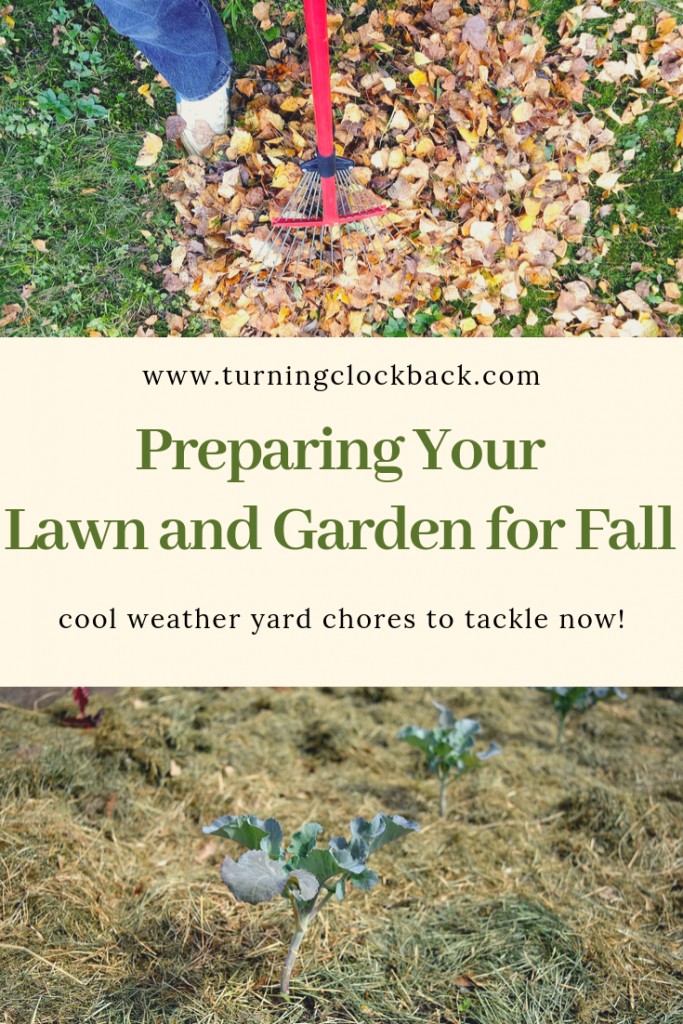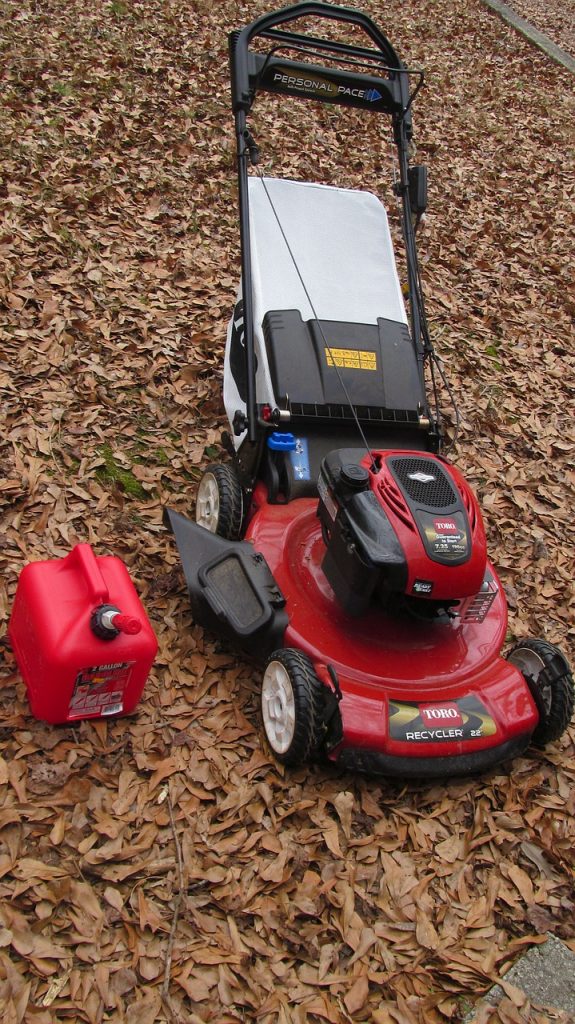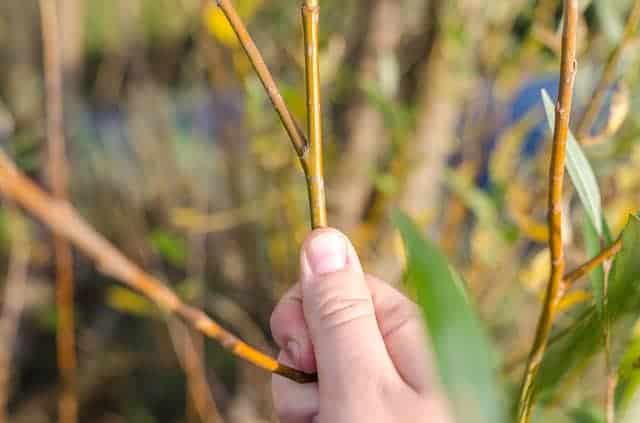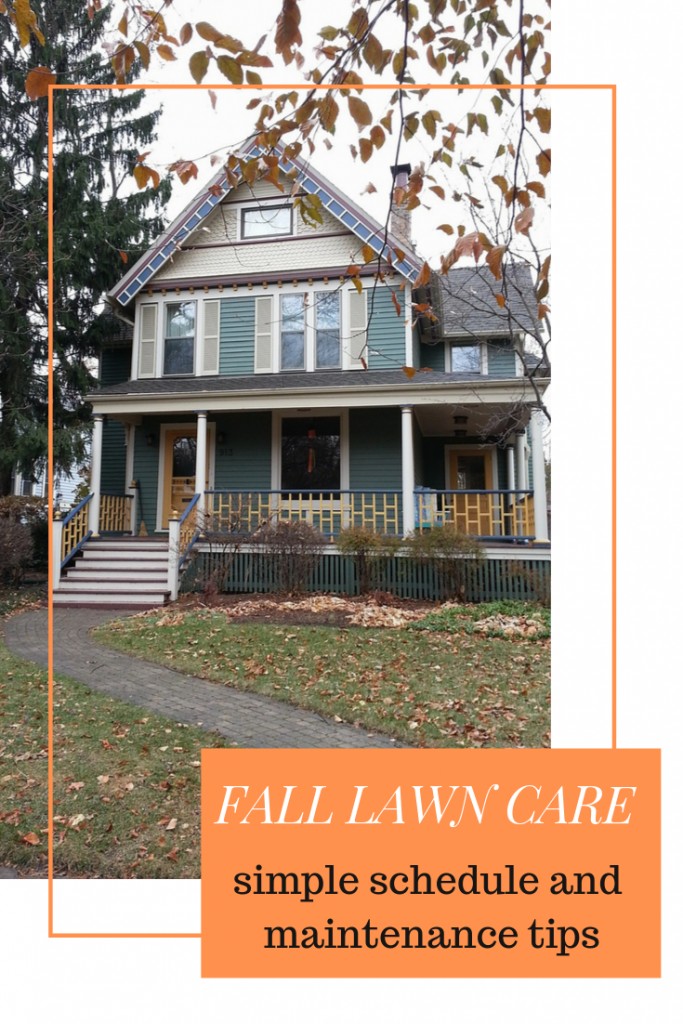The weather is cooling off and it’s time to prepare your yard for winter. What fall outdoor chores should you tackle first? Here are a few tips for preparing your lawn and garden for fall.
Posts feature partner companies & may be sponsored. Post contains affiliate links & I will be compensated if you make a purchase after clicking on links. As an Amazon Associate I earn from qualifying purchases.

Table of Contents
How do I prepare my yard for fall?
Now that summer has passed and the cool weather is here, you might think that your yard work is finished until spring. You’d be amazed how much work is still left to do!
Depending on which region of the country you live in, your lawn and garden will have different needs over the next few months. Now is the perfect time to start preparing your lawn and garden for fall. Here are some useful tips that you should consider this fall:

✯Don’t want to miss the next post?✯
Follow Turning the Clock Back on Facebook | Twitter | Pinterest
Or join the private Facebook group for simple tips on going green!
Rake fall leaves for lawn health
I know it’s a tough job, but getting those leaves off the ground is vital to avoid smothering your grass. If that happens, you’ll be left with giant patches of bare soil next spring instead of lush green grass! Skip the leaf blower and use your own muscle power to move those leaves!
Tips for Core Aeration of Your Lawn
Consider buying a lawn aerator to prevent thatch buildup, encourage root growth, and create soil that is less compact. You could also just walk around in lawn aerating shoes, but, I’m not sure how well those actually work!
- Mow your lawn before aerating it.
- Water your lawn thoroughly two days before aeration
- Do not remove the plugs! You prevent them from releasing their nutrients and microorganisms to the soil below if you remove them.
- Apply fertilizer immediately after aerating your lawn
- After aerating, reseed your lawn, especially in areas where the grass is thin.

Should you cut your grass in the fall?
Preparing your yard for winter is incredibly important. Even though your lawn isn’t growing very fast, it still needs to be trimmed every couple of weeks until the really cold weather sets in.
Invest in a reel mower for an eco-friendly trim. This is a great opportunity for a nice outdoor workout and you can eliminate all the emissions that come from traditional lawnmowers.
Like this post about preparing your lawn and garden for fall? Read these posts, too:
- Fall Gardening Tips and Putting the Garden to Bed
- 8 Plants that Bloom in Winter Perfect for Your Back Yard!
- Growing Your Own Garlic Starts in the Fall!
Fertilize and reseed grass when the weather is cool
What is the best fertilizer for grass in the fall? There are many natural fertilizers available that contain things like bone meal, feather meal, fish emulsions, liquefied kelp, and other all-natural and organic ingredients.
The benefit of natural fertilizers is that you don’t have to worry about kids and pets playing on your lawn and being exposed to harsh chemicals. Add new seed to your lawn and water it well for a couple of weeks to ensure a lush lawn in the spring.

Pruning your plants in the fall
Pruning is important to ensure healthy growth in the spring. Wait until after the leaves turn, indicating that the plant is dormant. If you prune too soon, you will encourage new growth that will be damaged during the first frost.
Tips for using leaves and grass clippings in fall composting
Creating a compost pile needs to be on your list of fall yard work to tackle. You can use those leaves you raked up from your lawn or purchase wood chips or recycled tire mulch.
Spreading a layer of mulch around the base of plants provides insulation and helps retain moisture. If you have compost from your compost bin, consider working it into your garden beds at this time.
- Use leaves from deciduous trees. That means the ones that fall on the ground in the fall!
- Avoid using evergreen leaves. That includes plants like holly, laurel, and pine trees.
- Wait until the leaves turn brown before composting them. I know you are eager to start preparing your lawn and garden for fall, however, be patient! Just let them drop, rake them up, and dump them in the compost.

Plant crops that grow well in the fall
There are many cool-weather plants that will grow and produce food throughout fall and early winter. Broccoli, snow peas, radishes, winter squash, and leafy greens like lettuce and spinach all love cool weather.
If you are not interested in growing a fall garden, you still have work to do. Preparing vegetable gardens for winter will help ensure a productive spring crop.
Fast-growing fall crops like lettuce and radishes can be planted into late September. Plants with long growing seasons like leeks, broccoli, Brussels sprouts, etc may need to be planted in shady areas during August to allow them to mature. Check out my post about what to plant in November (both inside AND out!) for more fall crop ideas.

Fall bird watching
Now is the time to clean old nests out of nest boxes and scrub your bird feeders. Check out my post on winter bird feeding tips for great cold weather bird seed tips.
If you live in a particularly cold region, consider a bird bath heater to keep the water from freezing solid in your bird bath. Freezing and thawing will damage your ceramic or stone baths.
If you don’t have a good way to keep them warm, consider keeping them empty for the winter. You can put out a small plastic or metal tray to ensure your birds have an adequate water supply this winter.

Fall lawn care schedule for Beginners
There are several ways to make lawn and garden care more eco-friendly. The use of “reel mowers”, organic fertilizers, and a little bit of elbow grease will ensure a healthy lawn and garden come spring – without increasing your carbon footprint too much!
What are you doing in your yard this month? Here is a basic fall lawn care schedule for beginners:
Early fall lawn care (late summer/early fall)
Tackle bare spots, thinning grass, and dead areas. Use a dethatching rake to remove dead grass and aerate the soil. Top with a bit of compost and/or fertilizer and reseed.
Mid-fall yard chores
Tackle the whole lawn. Cut the grass and water thoroughly. About two days later, use a core aerator and reseed the whole lawn. Hold off on more fertilizer. Trim and edge the landscaping.
Late fall gardening and lawn care
Clean up all the leaves and debris that you don’t want to overwinter. Mulch the debris into the grass with a mulching lawn mower to keep the nutrients in the soil or toss them in the compost bin.
A little bit of fall lawn care NOW will help your grass stay green and lush the rest of the year. Remember, choose environmentally friendly lawn care products whenever possible to ensure a safe place for kids and pets to play. Check out Yardcare.com for more information about fall lawn care.

Diane is a professional blogger and nationally certified pharmacy technician at Good Pill Pharmacy. She earned her BS in Microbiology at the University of New Hampshire and has worked in cancer research, academics, and biotechnology. Concern over the growing incidence of human disease and the birth of her children led her to begin living a more natural life. She quickly realized that the information she was learning along the way could be beneficial to many others and started blogging and freelance writing to share this knowledge with others. Learn more about her HERE.
